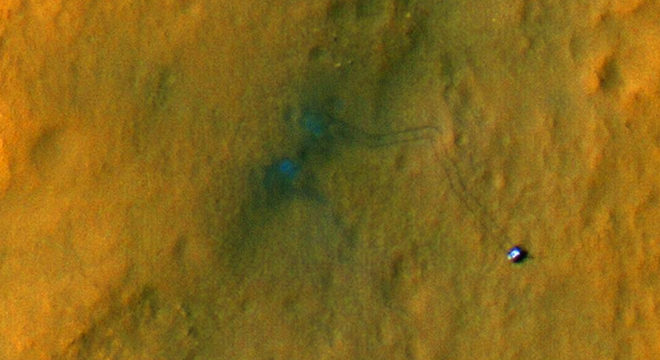NASA’s Mars Curiosity Rover has now driven 358 feet, about the length of a football field since, landing on the Red Planet exactly one month ago, NASA reported on Thursday.
The latest drive spurt, also the rover’s longest yet at 100 feet, occurred on Tuesdsay. NASA said it employed a “dogleg” maneuver during the drive, which allowed the six-wheeled, car-sized rover to narrowly avoid a patch of sand which would have slowed it down and could have caused other problems.
Curiosity now sits about a quarter of the way to its first destination, an area of diverse Martian geology known as “Glenelg,” where NASA intends to deploy the rover’s 7-foot-long robotic arm and onboard drill and sample soil for the first time.
But before that, last weekend, on September 2nd, NASA was able to snap one of its clearest satellite photos yet of the rover, using a giant reflective mirror telescope called the HiRISE instrument, located aboard NASA’s Mars Reconnaissance Orbiter satellite, which has been orbiting the Red Planet for the past six years.

This new HiRISE imagery clearly depicts the rover as a tiny, shiny spot to the right, with two parallel wheel tracks extending behind it, showing the rover’s path from its landing site, which NASA has christened “Bradbury Landing” after the revered sci-fi author. Two two dark spots at the landing site are where the rover’s descent stage thrusters scorched the Martian surface and blew the top soil away.
NASA also published another photo captured by HiRISE showing the parachute (at left) and the rover landing craft’s backshell (at right), both of which disconnected from the rover before it was dropped relatively gently to the surface by a hovering “sky crane.”

The impact site of the sky crane is seen in another HiRISE image, clearly shown in blue:

As NASA pointed out, the image has been color-enhanced to show details more clearly, but the tracks are all clearly visible to the spacecraft, as is the rover itself.
On Wednesday, the rover sat stationary as NASA scientists began testing its robotic arm, a phase that’s expected to take the next six days.
As Daniel Limonadi, lead systems engineer for Curiosity’s surface sampling and science system, said in a statement posted online Thursday:
“We will be putting the arm through a range of motions and placing it at important ‘teach points’ that were established during Earth testing, such as the positions for putting sample material into the inlet ports for analytical instruments…These activities are important to get a better understanding for how the arm functions after the long cruise to Mars and in the different temperature and gravity of Mars, compared to earlier testing on Earth.”
NASA wanted to show off the rover’s robotic arm before it got to work though, publishing the following image of the arm, retracted, as taken by one of the onboard mast cameras, or Mastcam:

Still, in overall terms, the Curiosity mission, also known as the Mars Science Laboratory, has just begun: The mission has an official timeline of 23 months, during which time NASA will drive the rover up a nearby mountain known as Mount Sharp.






